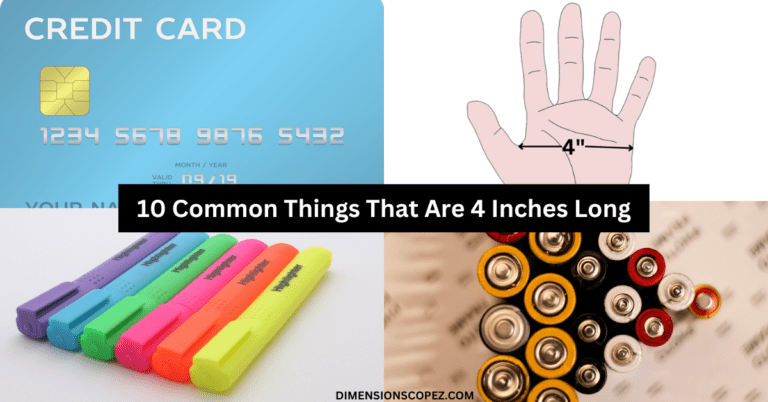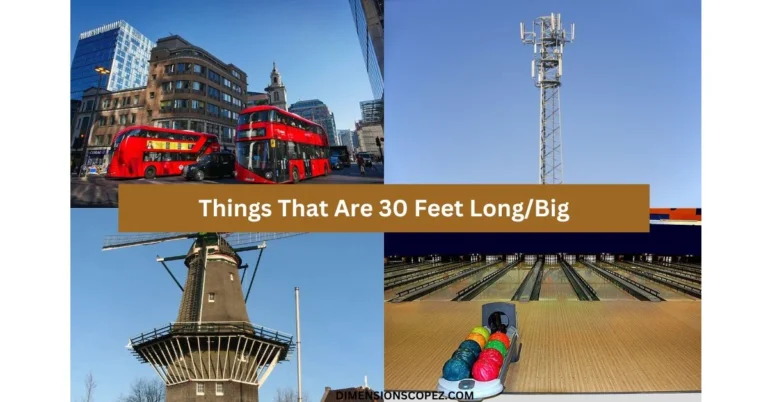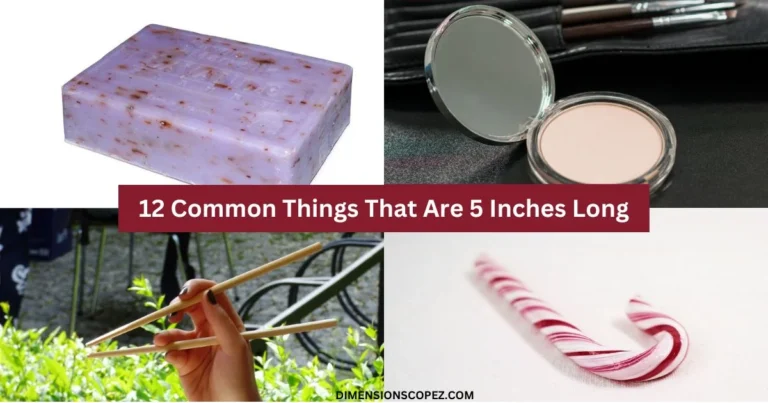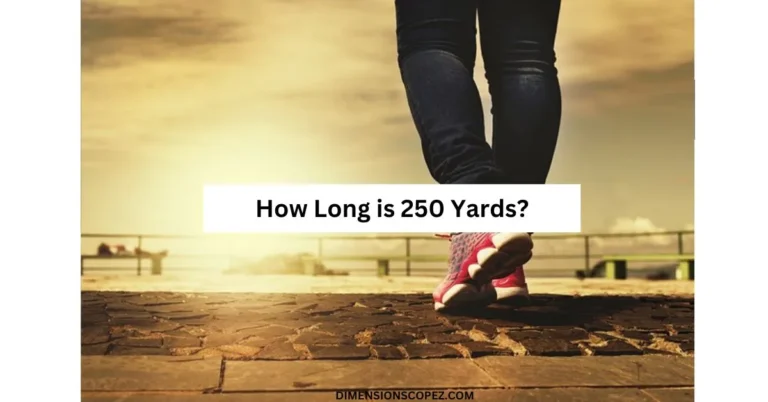9 Everyday Items That Are 10 Centimeters Long
Measuring the length of 10 centimeters is not easy if you don’t have a measuring tool. But worry not—we’ve compiled a list of everyday objects and things that can measure approximately this length. Through these examples, you can get a rough estimate of this size.
In addition, we will discuss how 10 cm is visualized on a ruler. Understanding this length enhances our knowledge of basic measurements and gives us a clearer picture of the dimensions of everyday objects we interact with.
Without any delay, let’s embark on this exploration together and discover the significance of this measurement.
How Long is 10 Centimeters?
Ten centimeters equals about 3.94 inches, falling just shy of the 4-inch mark. In the metric system, it is equal to 10 centimeters and serves as a fundamental unit of length that helps people measure and quantify the world.
This length can be visualized as slightly less than the length of a standard smartphone or about the diameter of a large coffee mug. Understanding this measurement can help you in various scenarios, from estimating distances to gauging the size of objects without a ruler.
How Big is 10 Centimeters on a Ruler?
Visualizing 10 cm on a ruler is a straightforward way to grasp this measurement accurately. Ten centimeters are clearly marked and easily identified on a standard metric ruler. Each centimeter on a metric ruler is divided into 10 millimeters, making it simple to understand even smaller measurements.
When you look at a 12-inch ruler, which typically includes a metric scale, ten centimetres will be one-third (1/3) of the ruler’s length. This section usually consists of a series of longer marks, each representing a single centimeter, and shorter marks for millimeters.
Locating the 10-centimeter mark on such a ruler is an excellent exercise in visual measurement, helping one build a mental image of this length.
Things That Are 10 Centimeters Long
There are nine everyday objects we see in our daily lives and usually interact with, but we don’t know their equal size and dimensions. If you are looking for ten cm long items, you’ve clicked on the right page.
1. Popsicle Stick

A standard popsicle stick is a perfect example of an item about 10 centimeters long. Often overlooked, the humble popsicle stick is not just a frozen treat holder but a useful tool in crafts and education. Measuring roughly ten centimeters provides a straightforward way to understand this measurement.
Teachers frequently use popsicle sticks in the classroom to help students visualize and learn about length. They are also popular in arts and crafts, serving as stakes for plant labels, supports for small structures, or materials for creative projects, emphasizing their utility based on size.
2. Half a Standard Brick

Bricks are one of humankind’s oldest and most fundamental building materials. Typically made from clay or shale, they are formed into rectangular blocks and then fired in a kiln to harden them for use in construction.
A standard brick measures about 8 inches long and 3.5 inches wide, so half a brick will be about 4 inches or ten centimeters. However, dimensions can vary globally, with bricks in some countries being larger or smaller based on local building practices and standards.
A half-brick might be used in building projects to create ends or aesthetic brickwork patterns requiring shorter lengths.
3. Two Golf Tees

These small stakes elevate the golf ball above the ground, making them crucial for every tee shot in golf. When paired, golf tees, typically about 5 centimeters each, make up the 10-centimeter measurement. The tee size is important as it affects the ease of hitting the ball and its trajectory.
Combining two tees demonstrates this length in a practical context, making it relatable for golf enthusiasts or anyone familiar with the sport. This measurement also shows the precision required in sports equipment, where a few centimeters can significantly influence the game’s dynamics.
4. Men’s Wallet

If you look at your pocket, the wallet is another practical illustration of an object measuring around this size. Usually, the wallet has a length of around 3 to 4 inches when you fold it. Four inches is equal to approximately 10 cm. This typical length allows the wallet to comfortably fit in a standard trouser pocket, often slightly larger than ten centimeters.
The dimensions of a wallet are critical as they must be large enough to hold essential items like credit cards and currency, which are standardized sizes while remaining compact enough for portability. This balance makes your wallet an excellent example of how everyday objects are designed with specific dimensions for practicality and ease of use.
5. Two Credit Cards

A standard credit card measures approximately 8.56 centimetres in length and 5.4 centimetres in width. If we place two standard credit cards side by side, the total length is about 10.8 cm, slightly exceeding ten centimeters, providing a practical, real-world application of this measurement.
Credit cards are small metal or plastic cards that banks and other financial institutions give us to borrow money to pay for things. You can buy things or get cash advances, but you’ll have to pay back the loan amount plus any interest or fees that may have been added. Based on how much a person spends, credit cards often come with extra benefits like points, cash back, or free travel.
6. Hand width
The hand size can vary slightly from person to person but generally provides a good estimate for quick measurements without a ruler. The average width of an adult’s hand, measured across the palm just below the fingers, typically approximates ten centimeters.
The hand has historically been used as a unit of measure in various cultures and contexts. Today, using one’s hand width as a reference point can be especially handy in informal settings, such as measuring fabric-cuts or estimating the size of household items. Here are things that are 2 mm long/thick.
7. Teaspoon

A standard teaspoon, a common utensil in kitchens worldwide, measures about four to five inches long: its ten-centimetre size makes it easy to handle and manoeuvre within small containers, such as spice jars and teacups.
Also, it is an essential tool for measuring smaller quantities of liquids like extracts, oils, or syrups, as well as dry ingredients like baking powder, baking soda, yeast, or spices. Whether you’re adjusting the flavour of a dish with salt or adding just the right amount of baking soda to a cake batter, the teaspoon serves as a quick and easy gauge for small volumes.
8. Two Erasers

If you use a pencil, you must need an eraser to fix the mistakes. Did you know that a rectangular eraser typically measures about 5 centimeters or 2 inches in length? Placing two of these erasers end-to-end visually represents the ten-centimeter mark.
This size is practical for handling and provides sufficient surface area for erasing without being cumbersome. In educational settings, using erasers as a tool for visual measurement helps students understand and apply the concept of length tangibly, reinforcing the metric system through a common classroom item.
9. Crayon

A standard crayon is also an excellent example of things that measure 10 cm. Crayons are colourful wax-based drawing tools primarily used by children for arts and crafts. Each crayon is approximately close to ten centimetres, providing a suitable size for us to hold and manipulate easily.
This length is ideal for providing a good grip for children’s small hands, facilitating motor skills development and artistic expression. Understanding the measurement of a crayon can be particularly enlightening in educational discussions about manufacturing standards and ergonomic design for children’s products.
Conclusion
By exploring these common things that come in 10 centimeters, we can better realize the practical implications of this dimension in various aspects of daily life, from construction and design to personal use and educational applications.
As we’ve discussed, it is a surprisingly common length found in many everyday objects. From popsicle sticks to men’s wallets and even in pairs of golf tees or credit cards, this dimension is everywhere. Understanding how to visualize and measure this length can simplify many tasks and decisions, whether crafting, playing, or organizing.







